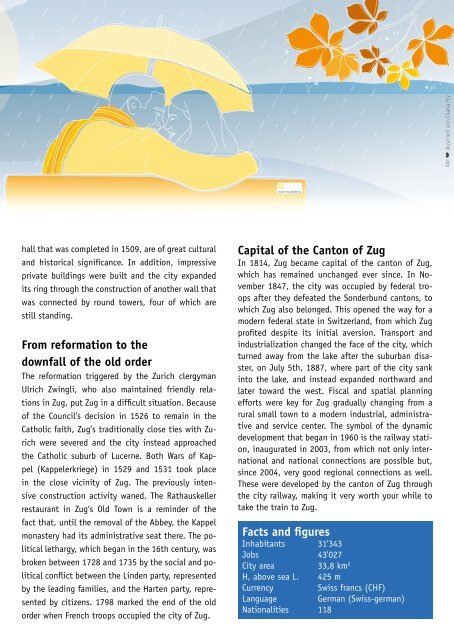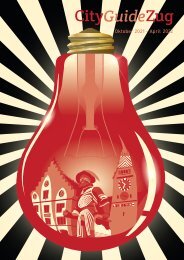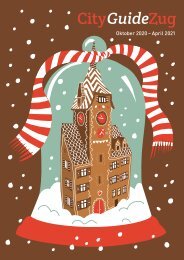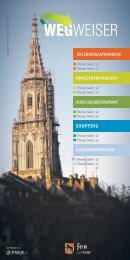Guide Zug Herbst/Winter 2022/23
Guide Zug Herbst/Winter 2022/23
Guide Zug Herbst/Winter 2022/23
Sie wollen auch ein ePaper? Erhöhen Sie die Reichweite Ihrer Titel.
YUMPU macht aus Druck-PDFs automatisch weboptimierte ePaper, die Google liebt.
Mit ❤ illustriert von Diana Fry<br />
hall that was completed in 1509, are of great cultural<br />
and historical significance. In addition, impressive<br />
private buildings were built and the city expanded<br />
its ring through the construction of another wall that<br />
was connected by round towers, four of which are<br />
still standing.<br />
From reformation to the<br />
downfall of the old order<br />
The reformation triggered by the Zurich clergyman<br />
Ulrich Zwingli, who also maintained friendly relations<br />
in <strong>Zug</strong>, put <strong>Zug</strong> in a difficult situation. Because<br />
of the Council’s decision in 1526 to remain in the<br />
Catholic faith, <strong>Zug</strong>’s traditionally close ties with Zurich<br />
were severed and the city instead approached<br />
the Catholic suburb of Lucerne. Both Wars of Kappel<br />
(Kappelerkriege) in 1529 and 1531 took place<br />
in the close vicinity of <strong>Zug</strong>. The previously intensive<br />
construction activity waned. The Rathauskeller<br />
restaurant in <strong>Zug</strong>‘s Old Town is a reminder of the<br />
fact that, until the removal of the Abbey, the Kappel<br />
monastery had its administrative seat there. The political<br />
lethargy, which began in the 16th century, was<br />
broken between 1728 and 1735 by the social and political<br />
conflict between the Linden party, represented<br />
by the leading families, and the Harten party, represented<br />
by citizens. 1798 marked the end of the old<br />
order when French troops occupied the city of <strong>Zug</strong>.<br />
Capital of the Canton of <strong>Zug</strong><br />
In 1814, <strong>Zug</strong> became capital of the canton of <strong>Zug</strong>,<br />
which has remained unchanged ever since. In November<br />
1847, the city was occupied by federal troops<br />
after they defeated the Sonderbund cantons, to<br />
which <strong>Zug</strong> also belonged. This opened the way for a<br />
modern federal state in Switzerland, from which <strong>Zug</strong><br />
profited despite its initial aversion. Transport and<br />
industrialization changed the face of the city, which<br />
turned away from the lake after the suburban disaster,<br />
on July 5th, 1887, where part of the city sank<br />
into the lake, and instead expanded northward and<br />
later toward the west. Fiscal and spatial planning<br />
efforts were key for <strong>Zug</strong> gradually changing from a<br />
rural small town to a modern industrial, administrative<br />
and service center. The symbol of the dynamic<br />
development that began in 1960 is the railway station,<br />
inaugurated in 2003, from which not only international<br />
and national connections are possible but,<br />
since 2004, very good regional connections as well.<br />
These were developed by the canton of <strong>Zug</strong> through<br />
the city railway, making it very worth your while to<br />
take the train to <strong>Zug</strong>.<br />
Facts and figures<br />
Inhabitants 31'343<br />
Jobs 43'027<br />
City area 33,8 km 2<br />
H, above sea L. 425 m<br />
Currency Swiss francs (CHF)<br />
Language German (Swiss-german)<br />
Nationalities 118
















